City staff have created a list of non-lethal deer management techniques that allow residents to reduce deer impacts on their property. We have listed a variety of techniques that are allowed within the City of Ann Arbor and have scientifically shown efficacy. Residents who want to reduce deer impacts on their property should review and consider implementing these various strategies.
Exclusion Methods -
Individual Plants - Repellents -
Deterrents - Feeding Ban -
Learn More
Encourage Deer to Leave the Area
A method that can be used to relieve deer damage is to scare deer from an area where they are taking cover. This disrupts their normal behavior patterns and encourages them to temporarily leave the area. Scaring deer away is most effective when the area is fenced and the deer can be prevented from returning to the area. This technique can cause deer to flee cover where they find security, which can provide temporary damage relief. This can also be used to remove deer prior to trying exclusion techniques, in particular, fencing.
Do this by having a group of people noisily walk through cover where deer are known to take refuge during daylight, near the area where deer damage is occurring. This technique may provide temporary relief from deer damage, but the effects can be short-lived. How effective scaring deer is depends on how habituated the deer are to humans. Individuals should use discretion when using this method to prevent moving deer into vehicular traffic.
Exclusion Methods
Fencing -
Wire Fencing -
Plastic Fencing
Exclusion methods prevent deer from accessing plants. Some methods reduce or eliminate deer damage. Exclusion methods include non-electric and individual plant protection. For exclusion to be effective, the barriers must be properly installed and maintained, and must deny deer entry. Exclusion is considered to be one of the most effective methods to reduce deer damage. When installed and maintained properly, this method can eliminate deer damage. Installation and maintenance of exclusion methods are additional costs that should be evaluated when considering exclusion as an option. Exclusion can be cost-effective over the long term, depending on the size of the area being treated and the value of protected plants. However, the unattractive appearance of some exclusion methods may preclude their use on landscaping plants.
Fencing
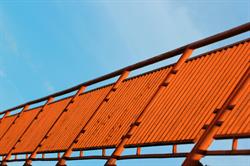
Fencing is the most reliable way to exclude deer from an area. It can last for many years, but requires occasional maintenance. Fencing should be considered for high value plantings that require year-round protection. For example orchards, landscape and tree nurseries, vineyards, and other high value plants require perennial protection. Fencing can be a practical, and cost-effective method for protecting small landscapes, gardens and small orchards.
Fencing can be costly to erect, and may require maintenance to remain effective, but it can be the most effective deterrent to deer damage. Gates, posts, and hardware are additional materials that may be needed, which will add to the cost of fencing an area. Installation and maintenance costs should also be considered before deciding on fencing as a deer damage deterrent.
Permanent fences can last for 30 years or longer, which can be particularly important when protecting perennial garden and vegetable beds. Temporary fencing is less expensive than permanent fencing, and can be useful in protecting plants for short periods of time. Examples for temporary fence uses include truck crops, gardens and flowers prior to harvest.
Ann Arbor's fencing ordinance is located in Article IV: Development Standards Sections 5.26.1, 5.26.2 and 5.26.3 of the Ann Arbor City Code. It states that:
“Fences located in residential zoning districts 1. Shall not exceed four feet in height and 50% Opacity in the Front Yard. 2. Shall not exceed six feet in height and 80% Opacity in the Side Yard. 3. Shall not exceed eight feet in the Rear Yard. Fences shall not be charged or connected to an electrical current, shall not contain spikes, nails, barbs (including barb wire), or other pointed instruments, or any cleaved selvages or any sharp points on wire fences that have not been removed or bent to eliminate any sharp extrusions."
Eight-foot high fences are generally recommended to exclude deer, as shorter fences may not exclude all deer. However there are shorter fence designs that have been proven to be effective. One such way is to create a slanted fence system, which uses a deer's poor depth perception to a homeowner's advantage. This creates a fence that is 6 feet tall using 8 foot long boards anchored at a 45 degree angle facing away from the property. The boards must remain entirely on the homeowner's property and should not overhang over any other property. A low cost version of this type of fence uses tensile wire where the wires are hung 1-inch apart with posts every 8 feet. Another type of fencing system is to have two layers of fences roughly 4 feet away from each other. Deer will avoid trying to clear both fences and will be hesitant to jump between the two.
Solid wood fences are ideal for creating a barrier where deer cannot see into the yard. This type of fencing is permitted to be used in backyards as a stockade fence. However, front yard fencing must be 50% opaque and may only be up to 4 feet high. Mid-yard fencing must be 80% opaque and may only be 6 feet high. Alternatives can be tensile wire fencing or polypropylene mesh fencing, which fall within the opacity requirements for all fencing regulations. Fences need to be properly anchored to the ground, and should conform to the ground contour to prevent deer from going under them.
Fencing may need to be made more visible to prevent deer from getting tangled in it, which could hurt both the fence and the deer. Where fencing is erected across known deer travel paths, flagging should be used to alert the deer of its presence. Brightly colored flagging can help deer avoid contact with the fence. Flagging should be in the blue to yellow spectrum and attached at waist height in 3 foot intervals along the fence. These colors are recommended as deer have dichromatic vision and do not process the color red, orange or pink as well.
When possible, fencing should be erected prior to deer damage to prevent deer from establishing feeding patterns. Deer can be very persistent once they've established a feeding pattern, which can make excluding them very difficult.
Habitat modifications, like vegetation removal and control, may be required to maintain some of the types of fencing mentioned here. For example, it may be necessary to remove shrubs along an edge, to prevent deer from accidentally running into and damaging a fence. Fence maintenance should include regular vegetation control. Fences erected in wooded areas may require repair when limbs or trees fall on the fence.
Wire Fencing
Woven wire fencing is constructed of metal wires woven together to form a physical barrier. Woven wire fencing in 8 foot or taller heights is considered the best permanent fencing to exclude deer. This type of fencing should be considered where deer damage is moderate to high. It can last for up to 30 years, needs relatively little maintenance, and comes in a variety of different styles and heights.
Woven wire fencing is highly resistant to damage because it is very flexible. It is expensive to purchase and install, but can be a cost effective remedy to protect valuable plantings. Because of its high cost, woven wire fencing should only be considered for high-value plantings that require permanent or perennial protection.
Woven wire fencing has been used successfully to exclude deer from agricultural crops, orchards, and tree and landscape nurseries. It is also used to exclude deer from roadways and airports where they may cause accidents. Chain-link fencing is a well-known type of woven wire fencing, though there are other types of woven wire fencing that adequately exclude deer. High-Tensile Fixed-Knot fencing is a less expensive alternative to chain-link fencing that excludes deer equally well.
Plastic Deer Fencing
Polypropylene or plastic deer fencing is a heavy plastic mesh that can be used to exclude deer in areas where damage is light to moderate. It can be used to prevent deer damage to gardens, landscaping, some crops and individual plants. It is more flexible than steel wire mesh and readily follows the ground contour.
Polypropylene mesh may sag and the manufacturer recommends that a cable be strung through the top of the fence to support it between posts. The mesh should be supported by posts spaced 3-4.5 yards apart, and can be fastened to poles using self-locking plastic ties.
Like other forms of fencing, polypropylene deer fencing must be properly anchored to the ground to adequately exclude deer. Stakes must be used to anchor the bottom of the fence, to prevent deer from crawling under it. Repair can be easily done using plastic self-locking ties to mend tears or by patching holes with another section of mesh material. There are two kinds of plastic mesh deer control fencing available, standard and heavy duty.
Polypropylene fencing is generally less expensive than other types of fencing. It is easier to install and repair, and blends easily with shaded and wooded areas. Polypropylene fencing is short-lived, when compared to wire fencing, but may last for up to 10 years, according to some manufacturer claims. Posts, hardware and tools will add to the cost of this type of fencing.
Winter weather can play a critical role in the success of polypropylene fences. Heavy snow accumulation can damage this type of fence and will require due diligence on part of the owner to maintain cleared fences.
Individual Plant Protection
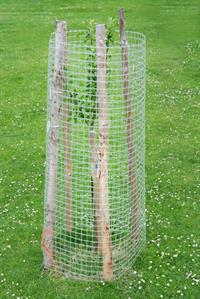
Tree Shelters, Wire Cages and Plastic Netting
Tree shelters, wire cages, and plastic netting around individual plants can exclude deer and prevent them from causing damage. Bark stripping is done in the fall of the year, when a buck rubs it's antlers against trees. Tree shelters can prevent antler rub damage, and can protect young trees from browse damage until the tree outgrows the height of the tree shelter. Wire cages four feet tall and one and one half foot in diameter can be placed around individual plants. Wire cages can prevent browsing and antler rubbing damage by deer.
Plastic netting, also called bird netting, is another material that can be used to exclude deer and can reduce deer damage. Plastic netting can provide temporary protection for seasonally harvested berries, fruit and some flowers. Netting typically works best in areas with light deer feeding pressure. Wooden stakes and self-locking ties can be used to anchor the netting over individual plants and to protect groups of plants.
Polypropylene fencing, netting, and repellents should be considered where aesthetic considerations limit the use of visually obstructive exclusion materials like woven or welded wire.
Repellents
Taste-based -
Odor-based -
Homemade vs. Commercial -
Drawbacks -
Advantages -
List of Repellents
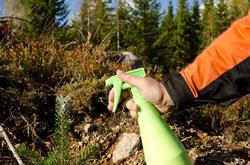
How They Work
Repellents work by emitting an alarming odor or bad taste that repels deer. They make treated plants less palatable and less desirable to deer. They have been used successfully to reduce damage to ornamental plants, vegetable gardens, orchards, and tree and landscape nurseries.
Repellents do not alter the aesthetics of plantings, and can be used where aesthetics cannot be compromised. They are effective when used in areas with low to moderate deer numbers. Repellents should not be expected to eliminate all damage, but they can help to reduce deer feeding damage to plantings. Some repellents are applied directly to plants and some are placed near plants that need protection. Repellents should only be applied according to label directions, to prevent damage to tender plantings. Most repellents can be placed into two categories: taste-based and odor-based. Multiple repellants used on a rotating basis have been shown to most effective in limiting deer habituation. If only using one repellent, expect its efficacy to last, at most, one week.
Taste-Based Repellents
Taste-based repellents impart a noxious taste that makes treated plants less palatable than untreated plants. Most taste-based repellents are applied directly to each individual plant and discourage deer from feeding because they don't like the taste. One kind of taste-based repellent is systemic. It is placed in the ground with the plant roots, and is absorbed by the plant as it grows. The chemicals absorbed by the plant impart a noxious taste to the plant, which deters deer feeding. A drawback of taste-based repellents is that deer must eat part of the plant before being repelled.
Certain taste-based repellents can be used on edible plants such as vegetable crops, fruits and herbs, but they must be washed off before eating.
Odor-Based Repellents
Odor-based repellents capitalize on a deer's keen sense of smell. Their odor discourages deer from feeding on the treated plants by producing an offensive or alarming odor, which repels deer. Some odor-based repellents can be placed into dispensers that can be attached to or near plants. Some odor-based repellents may use rotten eggs, animal parts, and soaps as active ingredients. Some use chemicals that deer find offensive. Other odor-based repellents use real or synthetic predator urines to repel deer. Repellents that use predator urines rely on the fact that large predators mark their territory with their urine. Deer are discouraged from entering areas frequented by these predators. Research shows that predator urine, from bobcats and coyotes, are the most effective repellents in deterring white-tailed deer specifically.
Odor-based repellents can be used to treat individual plants or for area treatments. One system of area treatment is called the rope fence system. This treatment is done by suspending a single strand of cotton rope, at waist height, on fence posts or stakes anchored around the perimeter of the impacted area. The rope is treated with an odor-based repellent that discourages deer from entering the fenced area. You can also use strips of cloth or dryer sheets treated with an odor-based repellent attached to stakes placed in the ground.
Homemade vs. Commercial Repellents
Repellents can be purchased commercially or they can be homemade. Homemade repellents can be inexpensive, but may not be as effective as some commercial repellents. Some examples of homemade repellents include:
- human hair clippings in a mesh bag
- crushed garlic cloves in a cloth bag
- deodorant soap attached to the plant by a string
Commercial repellents can be more expensive, but most have the advantage of being tested and developed for effectiveness. Newer repellent technology has incorporated sticking agents that adhere the repellents to the plants, making them last longer before needing reapplication. Some commercial repellents are reported to have worked for up to five weeks, before needing reapplication. Commercial repellents come in many different forms. Some come as solids, some must be mixed with water, and others come pre-mixed. Liquid repellents can be easily applied using a spray bottle or pump sprayer.
Repellent Drawbacks
Some drawbacks of repellents are:
- cost
- may need to be applied more than once
- they can be less effective as deer get used to them
Repellents can also be ineffective at deterring antler rubbing by deer. During the fall, male deer rub their antlers on trees to remove velvet, to polish their antlers, and to mark their territory. Plant enclosures like wire cages or tree shelters can be used to deter antler rub damage.
Repellents should be applied at the first sign of damage or if damage is expected, prior to any damage. Deer may eat plants that have been treated with repellents if alternative foods are not available. Snow cover can prevent deer from finding food, which can encourage them to feed on treated plants. Deer can become used to some repellents over time, referred to as “habituation." Repellents degrade and need reapplication, particularly after it rains or snows.
Not all repellents perform equally - some repellents are more effective than others at deterring deer damage. Using different repellents can prevent deer from becoming used to any one kind, and can be more effective than using just one kind. Due to their cost and varying effectiveness, repellents should only be considered as a method of reducing deer damage. Where larger areas need protection, other deterrents, exclusion or a combination of damage abatement measures should be considered. Weather, adjacent natural habitat and deer numbers influence the effectiveness of most repellents.
Repellent Advantages
Repellents can reduce deer damage to tolerable levels in areas where damage pressure is light to moderate. They can be a cost-effective treatment on small to medium-sized areas such as:
- gardens
- landscape plantings
- small orchards
- small- to medium-sized tree and landscape nurseries
Repellents do not alter the appearance of landscape plantings. This is helpful where exclusion methods would detract from the aesthetics of plantings. Commercial repellents are readily available at various retailers, and can even be ordered online. Most repellents are easily mixed and applied, and some come premixed and ready to use, in spray bottles.
Repellents are most effective when they are used in conjunction with other deer damage management techniques, like fencing and population reduction. Repellents are also more effective in reducing winter browse than summer browse and deer related rubbing.
List of Repellents
The following list contains both commercial and homemade repellents that have been used with success to reduce deer damage.
Commercial Repellents
(* Repellents marked with an asterisk denote that they are a repellent that can be used on edible plants. Remember to always follow the label instructions.)
- Deer Away / Big Game Repellent
- Liquid Fence
- Thiram
- Magic Circle
- Dr. T's Deer Blocker Hinder*
- Millers' Hot Sauce*
Homemade Repellents
- Human hair (2 handfuls) in mesh bag
- Worn clothes (with human odor) hung near plants
- Predator urine sprinkled on ground or cloths around plants
- Rotten eggs placed in vicinity of plants
- Blood meal or Bone meal scattered around plants on ground
- Deodorant Soap (any fragrant deodorant soap); shavings scattered on ground around plants; bar of soap hung from plants by a string
Repellents can be purchased at many nurseries, home and garden stores, home improvement stores, and some hardware stores. Repellents can also be purchased online or by mail order. Again, repellents do not prevent or eliminate deer browse on plants, they only reduce browse.
Deterrents
Scare Devices -
Auditory -
Visual -
Dogs
Deterrents include scare techniques, the electronic deer repellents, and dogs. Scare techniques are best used for short-term control of deer damage because deer can become habituated to them over time. Deterrent techniques can provide temporary relief of deer damage. For best results, deterrents should be used with other deer management techniques. Dogs used properly can provide long-term assistance. Deterrents are most effective at the onset of deer damage, before significant damage has occurred.
Scare Devices
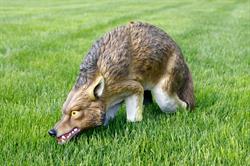
Most people picture a motionless scarecrow when they think of a scare device. Modern technology has helped create scare devices that incorporate motion and noise to be more effective at deterring deer. Scare devices can be used to frighten deer from yards, crops, and gardens. Scare devices are most effective when used as soon as damage is detected. These devices can be categorized as either auditory or visual deterrents, depending on how they work. Discretion should be used when employing scare devices. Some devices may be practical for use in rural areas. They may have limited use in suburban settings because they may violate noise ordinances and or may disturb neighbors. Please refer to Ann Arbor's ORDINANCE NO. ORD-12-33 NOISE CONTROL, specifically section 9:363 - Specific Prohibitions which states:
“No person shall engage in, assist in, permit, continue or permit the continuance of the following activities if the activity produces clearly audible sound beyond the property line of the property on which it is conducted even if the sound level is equal to or less than the dB (A) specified in Section 9:364: (2) The operation, between 10:00 p.m. and 7:00 a.m., of any device for killing, trapping, attracting, or repelling insects or other pests."
Scare devices can be effective at deterring deer damage, but deer can learn to overcome their fear of some scare devices over time. Field trials of various scare devices indicated that deer can become habituated to them after a week of exposure to them. Trials of various scare devices have produced variable results. No definitive studies have evaluated scare devices based on their effectiveness.
A combination of visual and auditory deterrents may be more effective than a single deterrent by itself. For the best results, try a combination of methods to prevent deer from getting used to any one technique. Deer are very adaptable, and can overcome their fear of some scare devices, if they learn that the device present no real danger. Moving scare devices around, imparting movement to the device, and using repellents in combination with scare devices can help improve their effectiveness.
Auditory Deterrents
Auditory deterrents can repel deer with their noise, and include noisemakers like whistles and ultrasonic devices. Most auditory deterrents should not be used in suburban or residential areas out of consideration for neighbors. Their use should be restricted to rural areas where noise is not a problem.
A radio, activated by a motion detector can scare off deer. Pie pans, metal cans, or wind chimes suspended by strings make noise when they rattle in the wind, and have also been used to deter damage. Field trials of some of these products showed that they deterred deer at first, but over time deer became used to the sounds.
Auditory deterrents may be useful in temporarily scaring deer. They may, however, need to be combined with visual deterrents and/or repellents to be effective at deterring persistent deer.
Visual Deterrents
Visual deterrents include:
- scarecrows
- flashing or strobe lights
- helium-filled Mylar and “Scare-eye" balloons
- Mylar tape and flagging that moves with the wind
- motion-activated water sprayers
Scarecrows work on the principle that deer fear humans, but may lose their effectiveness where deer are accustomed to seeing people. Odor-based repellents or motion can be added to scarecrows to increase their effectiveness.
Visual deterrents that move may be more effective at deterring deer, as deer readily detect and react to movement. Helium-filled “Scare-eye" or Mylar balloons, flagging and Mylar tape that move when the wind blows, have also been used to deter deer damage. Mylar is a shiny plastic material that reflects light and makes noise when the wind blows across it. It can be hung from stakes or plants like streamers to scare deer. Mylar tape twisted into a spiral, and suspended between posts, makes a buzzing sound when the wind blows over it, which can help deter deer.
Infrared motion sensors and/or timers can be used to trigger scare devices, which can scare away deer. Flashing and strobe lights, and water sprayers or sprinklers activated by motion sensors, or set on timers, can also deter deer. Motion-activated water sprayers, triggered by infrared or motion sensors, can prevent deer from getting used to them.
Remember that auditory deterrents combined with visual deterrents and / or repellents may be more effective than any one type of deterrent used alone.
Dogs as a Deterrent
Dogs can be used as a deterrent to discourage deer. A method sometimes employed is to tether a dog on a rope near the plants needing protection. The dog should scare away deer with its barking. It is important that the dog be energetic and willing to bark at the deer. Deer are adaptable and can learn to keep just out of the dog's reach or may tolerate the dog's barking. This technique can be useful in protecting small areas, such as home garden beds. However, in some situations deer may become aggressive, such a doe with a fawn, and stand their ground or charge the dog. It is important that if you are going to use a dog as a deterrent you should not leave the dog unsupervised in your garden or yard.
An extension of this method uses trained dogs to keep deer out of an area. The area to be protected is circled by a buried electric cable (invisible fence). The free-roaming dogs are fitted with a radio collar that emits an electric shock whenever the dog ventures near the perimeter of a buried cable. This “wireless fence" system trains the dogs to learn the boundaries of the area to be protected. With this system, dogs can move unrestricted within the area contained by the cable. This system has proven effective at reducing deer damage to larger areas like orchards and nurseries. This system can also be modified to protect landscaping around the home.
Feeding Ban
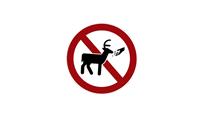
It is illegal to feed deer in Ann Arbor. Supplemental feeding is a technique that is sometimes proposed as a method to decrease deer browsing damage. However, this practice may have undesirable outcomes:
- it can lead to an increase in the overall health of adult deer temporarily
- can contribute to an unnaturally high concentration of deer
- can lead to increased deer damage problems
Concentrating deer may facilitate the spread of diseases between deer, cause the depletion of habitat, and may impact forest regeneration. In suburban and urban areas, feeding deer may also lead to an increase in vehicle strikes near the feeding area. Feeding deer can decrease their fear of humans, which may lead to dangerous deer-human interactions. Likewise, deer concentrated at feeding sites may also increase the risk of people contracting Lyme disease.
Ann Arbor's wildlife feeding prohibition ordinance, ORDINANCE NO. ORD-15-21 states:
"No person may place or permit to be placed on the ground, or less than five feet above the ground surface, any grain, fodder, salt licks, fruit, vegetables, nuts, hay or other edible materials which may reasonably be expected to result in deer feeding, unless such items are screened or protected in a manner that prevents deer from feeding on them. Living fruit trees and other live vegetation shall not be considered as deer feeding."
Want to Know More?
If you have any questions about non-lethal deer management techniques, please email at
[email protected] or call 734.794.6295. We hope that the information provided is useful to the citizens of Ann Arbor. We welcome any feedback you may have.
Here is a list of the documents the City of Ann Arbor reviewed for this article:
Beauchamp, G.K. 1997. Chemical signals and repellency. Pages 1–10 in J. R. Mason, ed., Repellents in Wildlife Management Proceedings. USDA National Wildlife Research Center. Fort
Collins, Colorado.
Beringer, J.,VerCauteren K., and Millspaugh J. 2003. Evaluation of an Animal-Activated Scarecrow and a Monofilament Fence for Reducing Deer Use of Soybean Fields
Wildlife Society Bulletin (1973-2006) Vol. 31, No. 2 (Summer, 2003), pp. 492-498
Beringer, J., L.P. Hansen, R.A. Heinen, and N.F. Giessman. 1994. Use of dogs to reduce damage by deer to a white pine plantation. Wildlife Society Bulletin 22:627-632.
Conover, Michael R. and Kania, Gary S., "Effectiveness of human hair, BGR, and a mixture of blood mean and peppercorns in reducing deer damage to young apple trees." (1987).
3 - Third Eastern Wildlife Damage Control Conference (1987). 10.
http://digitalcommons.unl.edu/ewdcc3/10
Curtis, P. D., C. Fitzgerald, and M. E. Richmond. 1997. Evaluation of the Yard Gard
Ultrasonic yard protector for repelling white-tailed deer. Proceedings of the Eastern Wildlife Damage Control Conference 7:172-176.
el Hani, Abderrahim and Conover, Michael R., "Comparative Analysis of Deer Repellents" (1995).
National Wildlife Research Center Repellents Conference 1995. 14.
http://digitalcommons.unl.edu/nwrcrepellants/14
Gallagher, George R.; Peacock, Jennifer L.; Garner, Elizabeth P.; and Prince, Robert H., "Conditioning and habituation of white-tailed deer to two common deterrents" (2000).Wildlife Damage Management Conferences -- Proceedings. 34.
http://digitalcommons.unl.edu/icwdm_wdmconfproc/34
Gilsdorf, Jason M., "Effectiveness of Frightening Devices for Reducing Deer Damage in Cornfields" (2002).
Dissertations & Theses in Natural Resources. 210.
https://digitalcommons.unl.edu/natresdiss/210
Ludwig, J., and T. Bremicker. 1983. Evaluation of 2.4-m fences and one-way gates for reducing deer–vehicle collisions in Minnesota. Transportation Research Record 913:19–22.
Lutz, J.A. and B.T. Swanson. 1995. Reducing deer damage to woody and herbaceous plants. Pages 231-240 in Repellents in Wildlife Management Proceedings. USDA National Wildlife Research Center. Fort Collins, Colorado.
Mason, J. R. 1998. Mammal repellents options and considerations for development. Vertebrate Pest Conference 18: 325-329.
Müller-Schwarze, D. Responses of Young Black-Tailed Deer to Predator Odors.
Journal of Mammalogy, Volume 53, Number 2, 1972, pp. 393 to 394.
Palmer, W.L., J.M. Payne, R.G. Wingard, and J.L. George. A Practical Fence to Reduce
Deer Damage.
Wildlife Society Bulletin, Volume 13, Number 3, 1985, pp. 240 to 245.
Palmer, W.L., R.G. Wingard, and J.L. George. Evaluation of White-Tailed Deer
Repellents.
Wildlife Society Bulletin, Volume 11, 1987, pp. 164 to166.
Risenhoover, K. J. Hunter, R. Jacobson, and G. Stout.
Hearing Sensitivity in White Tailed
Deer. Department of Wildlife and Fisheries Sciences, Texas A & M University, College
Station, TX, 1997.
Romin, L.A., and L.B. Dalton. Lack of Response by Mule Deer to Wildlife Warning
Whistles.
Wildlife Society Bulletin, Volume 20, Number 4, 1992, pp. 382 to 384.
Scheifele, M. P., D. G. Browning, and L. M. Collins-Scheifele. Analysis and
Effectiveness of “Deer Whistles" for Motor Vehicles: Frequencies, Levels, and Animal
Threshold Responses.
Acoustics Research Letters Online, Volume 4, Number 3, July
2003, pp. 71 to 76.
Sullivan, T.P., L.O. Nordstrom, and D.S. Sullivan. Use of Predator Odors as Repellents
To Reduce Feeding damage to Herbivores II. Black-tailed Deer (Odocoileus Hemionus
Columbianus).
Journal of Chemical Ecology, Volume 11, Number 7, 1985, pp. 921 to
935.
Swihart, R.K. and M.R. Conover. Reducing Deer Damage to Yews and Apple Trees:
Testing Big Game Repellent™, Ro-Pel™, and Soap as Repellents.
Wildlife Society
Bulletin, Volume 18, 1990, pp. 156 to162.
Swihart, R. K., J. J. Pignatello, and M. J. Mattina. Adverse Responses of White-Tailed
Deer, Odocoileus Virginianus, to Predator Urines.
Journal of Chemical Ecology,
Volume 17, Number 4, 1991, pp. 767 to 777.
Ward, J.S. Limiting Deer Browse Damage to Landscape Plants.
Bulletin 968. The
Connecticut Agricultural Experiment Station, New Haven, CT, November 2000.
